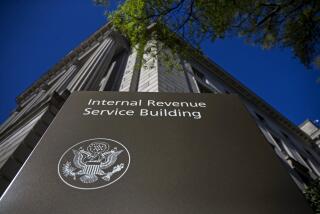Rules on Taxing of Social Security
- Share via
QUESTION: I have read everything I could regarding the new taxation of some Social Security benefits, and I still don’t understand why the taxation formula for taxpayers filing a single return is based on a $25,000 base while filers of joint returns are limited to a $32,000 base. Is this another case where a married couple is penalized? Why isn’t a married couple allowed a $50,000 free ride?--R. T. G.
ANSWER: Good question. As far as specialists in the field can tell, those are nothing more than arbitrary numbers devised by the congressmen who introduced the legislation that led to the law mandating taxation of some Social Security benefits.
But you would be hard pressed to find many government officials or tax specialists who view the numbers as a penalty to married couples. Ernst & Whinney tax specialist Mike Sedgwick sums up the views of many in his business: Writers of tax laws long ago realized that two people can live together more cheaply than two people can live apart. They cook one meal rather than two, and they share household expenses.
Using that line of reasoning, single taxpayers could argue that it is unfair for married taxpayers to get an exclusion twice the size of that allowed single taxpayers. But how the lawmakers arrived at a $32,000 break instead of a base of, say, $37,500--that is, 1 1/2 times that allowed single taxpayers--remains a mystery.
For readers not familiar with this setup, some Social Security benefits are now taxable. But to determine which are and which aren’t, Social Security recipients have to plow through a complicated formula. Basically, they are taxed on the lesser of 1) half of their net Social Security benefits or 2) half of whatever remains after they add their modified adjusted gross income and half of their net Social Security benefits and subtract that sum from this mysterious base figure. The base is $25,000 for single taxpayers, $32,000 for married taxpayers filing joint returns and zero for married taxpayers who live together but file separate returns.
Q: After reading in your column about new filing rules for Keogh plans, I took to heart your advice to call the IRS toll-free number if I had trouble filling out the complicated form 5500C that is now required. I was informed that the budget had not provided for anyone trained to help me with form 5500C! Print that in your column for further enlightenment of your readers.--A. H.
A: Here’s a footnote to that earlier column: In dealing with the IRS, it pays to be persistent. IRS officials themselves acknowledge that the people trained to answer questions coming into the toll-free number don’t always know how their superiors expect them to handle certain calls. This was one such case.
If you’re willing to make another stab at it, call the 800-424-1040 again. If you get the same response, insist on being transferred to a second level. And if an agent at the second level insists that he or she can’t help you, insist on being transferred to a third level. Don’t relent. IRS officials say there is no reason a taxpayer should be turned away empty-handed when they ask for help with this complicated form.
By the way, because there were so many last-minute complaints about this new filing requirement and because the IRS came to realize that many taxpayers weren’t aware of the filing date, the IRS has granted a filing extension on these Keogh forms, which were originally due July 31. As long as you file by Sept. 30, you won’t be penalized for filing late. (The usual late charge is $25 a day.)
Q: I am 70 1/2 this year and am getting conflicting information on when I must take distribution from the individual retirement account. Fidelity Federal Savings & Loan says distribution must begin no later than the first day of April following the calendar year during which I attain age 70 1/2. But a letter from the IRS says the above statement isn’t a ruling and I can’t rely on it as such. And Bank of America sent me a letter reminding me to take distribution in the same year in which I turn 70 1/2. Who is correct?--H. N.
A: Fidelity is. Anyone with money in an IRA must start withdrawing those funds by April 1 of the year after he or she reaches age 70 1/2. So, if you reach age 70 1/2 anytime in 1985, you must start withdrawing your money by April 1, 1986. That is a new rule that went into effect this year, which may account for the confusion.
Actually, that is the easy part. A more heated issue in retirement benefits circles at the moment is when the second distribution must be made. That assumes, of course, that you don’t withdraw the entire amount in one lump sum, a course that would be foolish for most people because the tax bill could be enormous.
The rules dictating how long IRA owners have to deplete their IRA savings accounts are complex. But essentially they require a taxpayer to withdraw the money all at once or in relatively equal portions in regular intervals over a period of years not to exceed the individual’s life expectancy or the combined life expectancies of the IRA owner and his or her beneficiary.
How do the experts interpret that? The most common interpretation is this: Make the first distribution no later than April 1 of the year following the year you reach 70 1/2, the second distribution before the end of that same year and succeeding distributions before the end of every year thereafter until you deplete the savings. So if you turn 70 1/2 this year, make the first withdrawal before next April 1, the second withdrawal by Dec. 31, 1986, the third by Dec. 31, 1987, and so on.
The minority view--but one that tax lawyers who hold this view believe they can defend in court--is that you don’t have to take the second distribution until a year after your first distribution. Under that view, you would authorize the first distribution by next April 1, the second one by the following April 1 and so on.
You’re on your own as to which you choose. The IRS hasn’t issued a ruling on the matter. But because it is such a hot issue, tax specialists predict that a ruling won’t be long in coming.
Debra Whitefield cannot answer mail individually but will respond in this column to financial questions of general interest. Do not telephone. Write to Money Talk, Business Section, The Times, Times Mirror Square, Los Angeles 90053.
More to Read
Inside the business of entertainment
The Wide Shot brings you news, analysis and insights on everything from streaming wars to production — and what it all means for the future.
You may occasionally receive promotional content from the Los Angeles Times.










